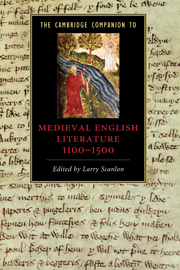Book contents
- Frontmatter
- Introduction
- Part I Contexts, genres, and traditions
- 1 Re-inventing the vernacular: Middle English language and its literature
- 2 Textual production and textual communities
- 3 Religious writing: hagiography, pastoralia, devotional and contemplative works
- 4 Romance
- 5 Dialogue, debate, and dream vision
- 6 Drama
- 7 Lyric
- 8 Lollard writings
- Part II Authors
- Guide to further reading
- Index
1 - Re-inventing the vernacular: Middle English language and its literature
from Part I - Contexts, genres, and traditions
Published online by Cambridge University Press: 28 November 2009
- Frontmatter
- Introduction
- Part I Contexts, genres, and traditions
- 1 Re-inventing the vernacular: Middle English language and its literature
- 2 Textual production and textual communities
- 3 Religious writing: hagiography, pastoralia, devotional and contemplative works
- 4 Romance
- 5 Dialogue, debate, and dream vision
- 6 Drama
- 7 Lyric
- 8 Lollard writings
- Part II Authors
- Guide to further reading
- Index
Summary
“So gret diversite”: characteristics of Middle English
And for ther is so gret diversite
In Englissh and in writyng of oure tonge,
So prey I God that non myswrite the,
Ne the mysmeter for defaute of tonge;
And red wherso thow be, or elles songe,
That thow be understonde, God I biseche!”
( Troilus and Criseyde, V. 1793-98)A language of great diversity: so Chaucer, at the close of Troilus and Criseyde, sums up the characteristics of English. They are characteristics that might lead to miscopying, misreading of the meter, and misunderstanding of his great epic. Clearly, the nature of the medium was of central concern and anxiety to Chaucer. But quite what he meant by “gret diversite” is not nearly so obvious to the modern reader of Chaucer and other texts of the period. Modern editions of medieval English literary texts often filter out original language features and introduce modern conventions, giving readers more easily accessible texts but reducing their exposure to the language. Modernized editions and translations limit even more their readers' access to medieval English.
Chaucer describes both the language, and writing the language down, as diverse. Two of the most important kinds of diversity (or variation) are change across time, and regional variation. “Middle English” denotes the language c. 1100- c. 1500 in all its variety, as distinct from “Old English” (or “Anglo-Saxon”), the language used before the Norman Conquest of 1066. Within that large category, linguists distinguish two broad historical varieties: early Middle English, and late Middle English, and five broad regional varieties: northern, east Midlands, west Midlands, southeastern, and southwestern. When it comes to written English, the regional and historical vectors of change intersect.
- Type
- Chapter
- Information
- Publisher: Cambridge University PressPrint publication year: 2009
- 1
- Cited by



